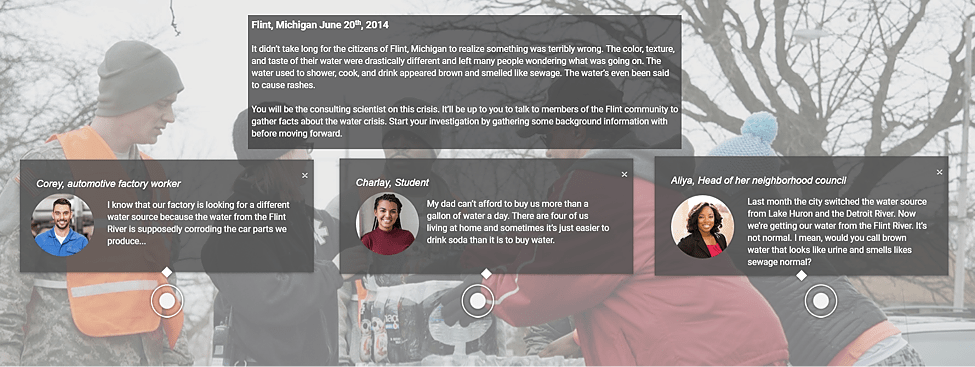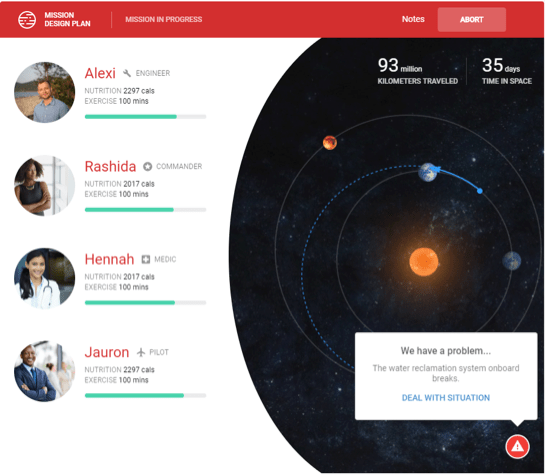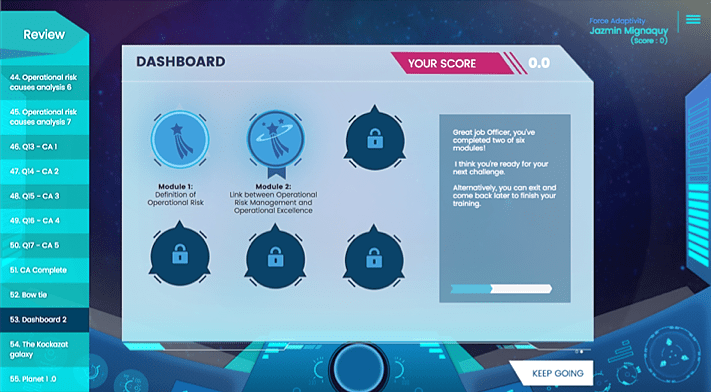Part of maintaining a design thinking mindset means being open to finding inspiration in unusual places. Though learning designers focus on education in our work, each of us has a wealth of daily experience that can provide us with a new perspective on our design challenges.
Recently, I was privileged to lead a design workshop within our US Learning Design Studio based around a fun and unique board game I came across called Stuffed Fables, an adventure game where 2–4 players take on the role of a little girl’s stuffed animal who comes to life at night, protecting her from the Nightmare King and his minions, who live under her bed.
Shared challenges in game and learning design
At first blush, it’s easy to think that playing a game has little to do with learning design — we have different goals and strikingly different media to work with.
Digging deeper, though, similarities become apparent. In both games and learning, there are complex systems and concepts for the user to understand, whether they be character skill mechanics in a role playing game or thermochemistry in a chemistry course. Likewise, both game designers and learning designers seek to streamline the flow and cognitive load on the user to avoid overwhelming them with the complexity of the topic or game system. We both make use of innovative mechanics, interactivity, and high-quality graphics, and there are instructions both for learning and for play that must be clear and concise. At their core, both games and learning experiences seek to develop and measure a skill, be it in the game mechanic or progress toward a learning goal.
Game design and learning design have a lot to teach each other. As learning designers, we can look to game designers for ideas to improve our narrative, our student engagement, our systems for supporting our students in routine tasks, simplifying patterns in our lessons, using tension and conflict productively toward a goal, and introducing unique mechanics for user agency and choice. Likewise, learning design principles can be used in games to scaffold complex mechanics, reach different player ability levels by breaking down game systems, support players who may be struggling with complex rules or strategy, improve player recall speed and accuracy, and reduce the difficulty of the learning curve for new players by improving tutorials and introductory games.
Game design and learning design have a lot to teach each other.
Broadening “gamification”
Often, the crossover between game design and learning design is referred to as the “gamification” of learning, which has led “gamification” to be a sometimes overused and usually under-defined term in discussions of educational technology. Typical gamification ideas include using games in the curriculum, adding concepts of badging or experience points, and encouraging competition.
While these are certainly game concepts that can be incorporated, what we found in our workshop is that we can incorporate game design principles deeper into what we do, blending game design and learning design into a single active learning experience with a shared goal.
In Stuffed Fables, we found several steps that the game’s designers had taken that we could incorporate into a learning experience from the ground up. Specifically, we admired how the creators of the game:
- Transformed constraints into strengths. Stuffed Fables has a comparatively small board. In most games this would be a daunting constraint, but the designers turned this constraint into a strength by using it to keep the game simple and fast-paced with a reasonable seat time for young players. Their decision catalyzed a discussion on how we can turn our projects’ constraints into strengths for our learners.
- Built a strong narrative and encouraged cooperativity. We were amazed at the strength of the game narrative and how well it weaved with the gameplay, encouraging cooperativity among the players. At no time was it more apparent than when, during a critical moment of our play through, three of our designers were rushing to save their colleague who was in danger! This motivation and feeling of urgency is something we are now exploring ways to encourage in our own students — how can we help build a sense of common goals, shared vision, and teamwork in our lessons?
- Constructed systems to aid players. We were impressed by the player aids and the color-coded (and colorblind friendly!) system employed in the game to simplify the routine tasks during each player’s turn. We used Stuffed Fables’ example to then look at some of our projects to see how we could provide aids and systems to reduce distractions and help our students focus on their goal: learning.
We also saw opportunities for improvement in Stuffed Fables based on learning design principles and our own struggles to learn the game’s ruleset and mechanics during our workshop. Some of our ideas for improvement included:
- Scaffolding the game introduction. Our learning design workshop participants represented a broad spectrum of gaming experience and enthusiasm, from seasoned veteran gamers to relative newcomers to complex tabletop games. Our newcomers struggled with the complexity of the rules as presented and suggested that a more scaffolded approach, breaking down the core mechanics through multiple exercises, might have reduced their sense of being overwhelmed. A highly streamlined “quick start” rule set and introductory scenario would have been a big help for them.
- Meeting needs of all personas. Stuffed Fables is labeled as a game for ages 7 and up, however, the rules are written at a reading level that is far higher than the average 7-year-old’s skill. By revising instructions, or providing a second set of instructions for younger players, designers could ensure that the game was accessible to all parts of the target audience.
- Collating reference data in a central location. In addition to the player aids provided in the materials, collecting key terms and mechanics in an easy reference sheet or packet would have been very useful during the game when players were wondering what certain terms meant, or how certain mechanics worked. Though these were present in the original rulebook, condensing into a reference would have sped the pace of play and reduced the learning curve by encouraging pattern recognition.
Examples from the Learning Design Studio
In our Learning Design Studio, we’ve already taken steps in the use of what we refer to as “gameful design” — incorporating game design principles and game elements seamlessly and holistically into our learning design. We’ve found that gameful learning design in our projects spans a spectrum from scores, badges, and achievements at one end to open play at the other end of the spectrum. Here are just a few examples of gameful design from recent projects:
1. Using Conflict and Narrative to Engage Students

Critical Chemistry: The Science of Saving Lives teaches chemistry principles using a narrative built around real-world events that threaten human health and safety.
The Inspark chemistry course Critical Chemistry: The Science of Saving Lives uses game design principles of powerful narrative and conflict in many lessons, where case studies feature real people and fictional characters engaged with life-threatening scenarios. Through these case studies, students explore chemical principles and concepts, motivated to resolve the conflict and providing valuable context for their learning. By tying learning to a strong and personal narrative, students can construct their knowledge in the framework of their own experiences, which research has shown leads to deeper understanding of concepts and longer retention.
Critical Chemistry also uses another game design pattern: breaking down large quests into smaller tasks. In one case study based on the Flint, Michigan, water crisis, the student’s overall objective is broken down into three smaller tasks. By using smaller tasks, in a similar manner to a teaching technique called “chunking”, the difficulty of each task is reduced, easing anxiety and lowering the student’s barriers to completion.
2. Applying Concepts in Context and Learning from Failure

The Launch Simulator in BioBeyond requires students to apply what they’ve learned about human anatomy and physiology to launch a successful mission to Mars. Failure in the mission is met with specific feedback on what went wrong.
In the Inspark Science Network biology course BioBeyond, students learn principles of human anatomy and physiology in the context of a crewed mission to Mars. The capstone experience for the unit, called A Mission Beyond, is a game-like launch simulator which requires students to select a ship and crew, and plan meals and exercise to keep their crew healthy on the way to Mars. The launch simulator brings in game design components with random challenges and encounters, student choices with consequences and trade-offs, and a clear mission objective: get to Mars healthy and ready to explore.
Unlike many learning experiences but like most games, there are varying levels of success possible — students’ mission may fail handily or by a small margin, may just barely succeed, or might succeed with lots of room to spare based on their decisions. Because the launch simulator tests skills that are directly related to the lessons of the unit, student learning is reinforced and tested, and feedback is provided on the student’s skill progression. When students fail, they are presented with the opportunity to retry their mission, learning from their failure and progressing by iteration. This type of experience — learning by failure and iteration — is particularly prevalent in open world games where players may encounter a challenge they are not ready for, fail, and restart from an earlier checkpoint.
3. Games to Change Thought Patterns

Dot’s Game and the river puzzle from the NRC Resiliency Series use game design principles to encourage thinking strategies that promote resilience, while maintaining an appropriate level of difficulty to require skill growth.
The Resiliency Series, developed in cooperation with the Northeastern Resiliency Consortium, makes heavy use of game components to teach concepts critical to building resiliency. From the curious, playful guide Dot, to the classic game Tower of Hanoi, through a traditional river crossing puzzle, and in our own Dot’s game, students are challenged to solve problems that seem easy at first and grow in complexity, involving planning, lateral thinking, persistence, and resilience. Games in the Resiliency Series were designed to provide an appropriate challenge for the student — enough difficulty to require thought and planning to overcome, but not so much as to be daunting.
Dot’s game blends learning design and game design particularly well, assessing student skills based on game performance, adjusting to a student’s proficiency, providing specific and critical feedback, and recommending lessons to help strengthen the student’s skill set. When paired with metacognitive activities — students thinking about their own thinking patterns — the insights provided by Dot’s game and other games in the Resiliency Series push students to explore, recognize, analyze, and change their own thought processes.
4. Mission-Driven Learning

The Australia and New Zealand Banking Group Operational Risk module is built using games and game design principles to challenge employees to identify operational risks in the ANZ Risk Universe as they build their skills.
The award-winning Australia and New Zealand Banking Group (ANZ) Operational Risk module uses gameful design to teach concepts which, at first glance, seem too sober for gaming: corporate training in risk identification. ANZ came to Smart Sparrow with the challenge of teaching risk identification in a dynamic, engaging manner that provided detailed insight into employee progress and development. To reach those goals, we designed a fictional universe, the ANZ Risk Universe, where employees must embark on missions to identify operational risks. Mission paths and objectives are tailored to the business unit of the employee, ensuring that each employee received the most relevant training possible.
By combining game design principles with learning design principles and detailed analytics, employees and supervisors receive crucial feedback on skill development while the employee experience is far more positive than with static and decontextualized training materials.
Building a Bridge
Projects that blend game design and learning design like ANZ, the Resiliency Series, BioBeyond, and Critical Chemistry are strong first steps toward a unified concept of games and learning.
Consider that games and learning have similar aims: the measurement, response to, and development of a latent skill or ability. In the case of a game, the skill might be spatial reasoning, tactical planning, ingenuity, or resilience. In learning, skills might include recall of knowledge, understanding of a concept, or application of a cross-cutting concept to multiple domains of knowledge.
A gameful learning experience brings together the best of game design and learning design principles to transform how people think and act. By building a bridge between game and skill, between learning and play, game-inspired learning creates a system that dynamically adjusts to skill and facilitates proximal development while maintaining engagement, fun, and even a sense of whimsy.
Gameful learning experiences bring together the best of game design and learning design principles to transform how people think and act.
We are not the first to dream of such a system; examples can be found in science fiction: the Young Lady’s Illustrated Primer in Neal Stephenson’s The Diamond Age, and the games of Battle School in Orson Scott Card’s Ender’s Game, to name just two. These learning experiences serve as a mark to aim for and inspiration for improvement of our own learning design: a reminder that as learning designers, we must constantly be open to the inspiration and lessons that fill our daily lives.
Incorporate Gameful Learning Design
If you’re interested in incorporating gameful learning design principles into your own students’ experience consider creating your own Smart Sparrow account to create your own lessons, checking out our Pedagogical Practices Library which ties gameful learning experiences to learning theories, or scheduling a meeting with our Learning Design Studio to explore how we can help empower you to take your own learners on an adventure.


